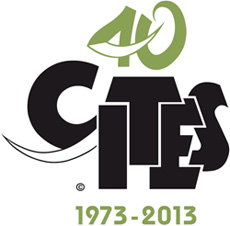Statement by CITES Secretary-General, John E. Scanlon
16 October 2013
At CBD CoP10, the Secretariat of the Convention on International Trade in Endangered Species of Wild Fauna and Flora (CITES) spoke for four biodiversity-related conventions in expressing support for the adoption of an inclusive Strategic Plan for Biodiversity 2011-2020 and set of Aichi Biodiversity Targets. Thereafter, the CITES Standing Committee oversaw the revision of the CITES Strategic Vision to take into account the Strategic Plan and its Targets, with the proposed amendments being adopted by the Conference of the Parties to CITES held in Bangkok, Thailand from 3 to 14 March 2013 (CoP16). 

CITES Parties have historically opted for short and concise strategic visions and in keeping with this tradition, CoP16 decided to adopt only a few changes to the structure of the Convention’s Strategic Vision in order to align it with the Strategic Plan and Aichi Targets. Significantly, it was the first time the CoP had ever incorporated into its decisions a decision taken in another forum.
The goals and objectives of the CITES Strategic Vision are preceded by a vision statement. This was amended to include an express reference to the Convention’s significant contribution to relevant Aichi Biodiversity Targets by preventing the overexploitation of wild animal and plant species through international trade.
The CITES Strategic Vision has three simple goals: to ensure compliance with and implementation and enforcement of its provisions; to secure the necessary financial resources and means for its operation and implementation and to ensure that the Convention and other multilateral instruments and processes are coherent and mutually supportive.
Before CoP16, the Goal 3 on linkages with other bodies and targets made specific reference to international financial mechanisms, relevant international environmental, trade and development organizations, relevant international organizations and agreements dealing with natural resources, the Millennium Development Goals and the sustainable development goals set at WSSD. At CoP16, references to the Strategic Plan for Biodiversity 2011-2020 and Aichi Biodiversity Targets were added to the objectives under Goal 3. This inclusion emphasized that CITES’ contribution to the Plan and its Targets would be strengthened through its ongoing efforts to ensure that international trade in wild fauna and flora is conducted at sustainable levels.
A decision was also taken at CoP16 to align the dates of the CITES Strategic Vision to coincide with those of the Strategic Plan for Biodiversity, hence the CITES Strategic Vision will now run until 2020.
Recognized at Rio+20 as an international agreement that stands at the intersection between trade, environment and development, CITES has always had a wide range of partners within the trade, socio-economic and well as environmental spheres.
The Strategic Plan for Biodiversity 2011-2020 and Aichi Biodiversity Targets have however become an important reference point for CITES Parties in putting into context their day-to-day work of ensuring that international trade in specimens of wild animals and plants is legal, sustainable and traceable and does not threaten their survival.